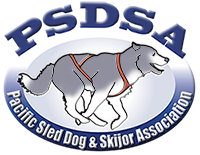TRAINING SUGGESTIONS
You should be sure that you and your dogs train and condition properly for skijoring or any physical activity. Before you train be sure you and your dogs are in good health. Know your dogs physical abilities and limitations, for their breed and as an individual. Many different types of dogs can participate in this sport, but not every is fit to or wants to. If you are uncertain about your dogs abilities ask a vet, someone else experienced with the breed or someone with experienced in skijoring. It is very helpful if the dogs have some obedience training.
For you, having some skiing experience is a plus, even if it is only downhill skiing. Knowing balance on skis is a great advantage since the dog will require training. Skijoring will come together sooner if the dog doesn’t have to stop frequenty for your falls. If you are new to skiing, it is highly reccomended that you take Nordic skiing lessons prior to training the dog.
HARNESS TRAINING SUGGESTIONS
-
Have your dog properly measured and fitted for a quality dog harness.
-
The first few times you put the harness on your dog, just let him wear it so he can get used to the feel of it. Give lots of praise and keep the sessions short (5 min).
-
Never leave your dog unattended wearing a harness.
-
To begin to teach your dog to pull, here are some techniques:
-
Take your dog for a walk with the leash connected to the harness instead of the collar. Try to keep the dog in front of you, with some tension on the leash.
-
Tie something light onto a lead to connect to the harness for your dog to pull (a small tire, piece of wood, etc.). If you do this work on a smooth surface it won’t get caught on a rock or bush. You can be in front encouraging and praising.
-
Sometimes it takes two people to teach a dog to pull. One behind with a lead and tension on the harness and the other to be ahead of the dog calling, encouraging, and praising (reward with treats, but not too many!).
-
The idea is for your dog to start feeling pressure on the harness without it being a struggle. It is very important for the dog to know this feeling is OK so encourage it. Make it fun.
-
Start working your way back behind your dog until he is pulling in front of you. Encourage him to lead not follow, and always have tension on the towrope.
-
It’s very important not to overdo a session. Once you’ve worked 15 minutes or your dog begins to do it right, give him lots of praise and stop for the day. Always end a training session on a positive note , even if the dog does not yet understand the idea. This will make him look forward to the next time.
-
The dog must be of medium build or larger, healthy, and have energy. It is recommended that the dog be at least one year old before he starts working due to muscle and bone development. Also, a quality diet is very important since you are training an athlete.
-
The amount of training for your dog may vary. Most northern breeds have the natural instinct to pull, other breeds may take a little longer to get the idea, and some dogs are just not suited for it. It takes a lot of patience on your part. Keep in mind the dog wants to please you. Keep your frustration away from a training session and try to make it a positive experience for your dog.
VOICE COMMANDS OFTEN USED
HIKE or LET’S GO to get started
EASY to slow down
WHOA to stop
GEE to turn right
HAW to turn left
GEE OVER to run on the right side of the trail
HAW OVER to run on the left side of the trail
COME AROUND or COME BACK to turn around
ON BY to pass another trail user or object of the dog’s interest
LINE OUT to get the dog to tighten up on the tow line prior to starting you ski
Some people prefer to use their own commands or variations of these words. Keep in mind that you may someday borrow a dog, let someone skijor with yours, or purchase a dog from a sled dog kennel. Teaching these commands is fairly standard in working dog language.
DO’S AND DON’TS
Do not over-run your dog. know your dog’s limitations and take rest stops when needed. Condition your dog to increase speed and mileage.
Do not feed your dog a meal less than 2 hours prior to, or immediately following, a run.
Do Always water/broth your dog 1 ½ to 2 hours prior to your run so your dog is well hydrated.
Do Always stop if your dog shows signs of injury, sickness, or fatigue.
Do Pay close attention to your dog’s feet and put booties on if he is getting snowballs, a worn pad, or if snow conditions are crusty and abrasive.
